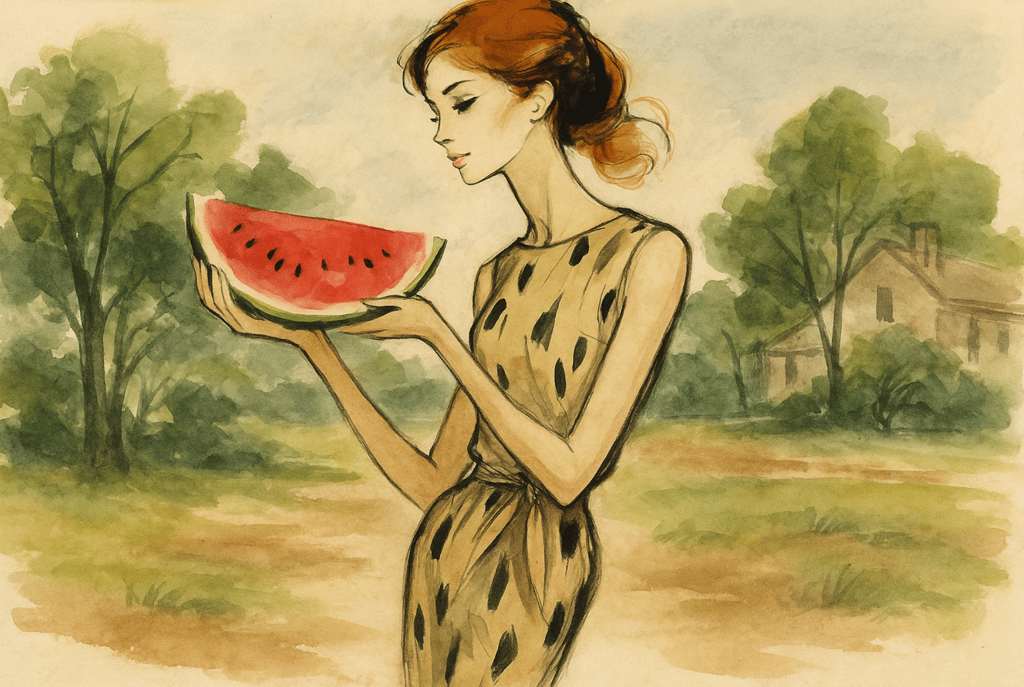Watermelon & Racism: A History of Stolen Joy and Reclaimed Meaning
Discover how watermelon went from a fruit of freedom for Black Americans to a racist stereotype—and how it’s now reclaimed as a symbol of resilience and protest, even standing in for the Palestinian flag.
FOOD HISTORY & TRADITIONS


For most of us, watermelon feels like pure summer: sweet, bright, hydrating, and refreshing. It’s a fruit of picnics and heatwaves, shared wedges and sticky fingers. But beneath that cheerful exterior lies a complicated story. In the United States, watermelon became one of the most weaponised symbols in racist propaganda—a tool used to demean Black Americans after emancipation. And, centuries later, the same fruit has taken on new layers of symbolism, used as a quiet act of defiance by Palestinians and their allies when the Palestinian flag is censored.
How did a simple fruit end up carrying so much weight? Its story is one of joy stolen, stereotypes forced, and meaning reclaimed.
Watermelon as a Fruit of Freedom
In the decades following the abolition of slavery in the 19th century, newly freed Black Americans embraced watermelon not as a joke, but as a symbol of survival and independence. The crop was inexpensive to grow, resilient, and highly profitable to sell. For many families, cultivating watermelon meant building small businesses—selling to local markets, setting up roadside stands, and even exporting crops to northern cities.
Watermelon wasn’t just food; it was a step toward economic autonomy at a time when many white landowners and lawmakers sought to keep freed Black citizens dependent and impoverished. It also became a fruit of celebration—shared at gatherings, Juneteenth events, and summer festivals, a reminder that freedom could taste sweet, even in hard times.
But that joy, and the progress it represented, quickly became a target.
How Racist Cartoons Turned Watermelon into a Slur
In the late 19th and early 20th centuries, as Black farmers and vendors found success with watermelon crops, white supremacists launched a cultural smear campaign. Racist postcards, minstrel shows, and political cartoons began depicting Black Americans as lazy, gluttonous, and childlike, often shown sitting barefoot in fields, devouring slices of watermelon with exaggerated features.
These images weren’t harmless caricatures; they were deliberate tools of oppression. They implied that Black Americans were unfit for full citizenship, too simple-minded and pleasure-driven to participate as equals in post-slavery society. They also sought to undermine the very success that watermelon farming brought, turning the fruit that supported Black livelihoods into a weapon of ridicule.
The stereotypes became so entrenched that, for generations, many Black Americans avoided eating watermelon in public. A simple act of refreshment risked being twisted into a racist joke—a theft of joy so complete that even the fruit itself became fraught.
Reclaiming the Fruit: Joy and Resistance
Despite its weaponisation, watermelon has remained a beloved part of Black culinary culture. Over time, it has been reclaimed as a symbol of resilience, a reminder that joy can survive, even when used against you.
Today, at Juneteenth celebrations and summer cookouts, watermelon often appears not as a burdened symbol, but as part of a collective reclaiming: a way of saying that the fruit’s sweetness, its ties to freedom and abundance, belong to the community—not to the caricatures designed to demean it.
Artists, activists, and chefs have also explored watermelon’s reclamation, using it in creative works and food events to spark conversations about race, history, and cultural pride. What was once a weapon has, in many spaces, been flipped back into something nourishing and unifying.
The Watermelon as a Flag: Solidarity with Palestine
Beyond the United States, watermelon has taken on yet another meaning in the 21st century—this time as a symbol of protest and identity.
Because the colours of a watermelon—its deep green rind, red flesh, black seeds, and white pith—mirror the Palestinian flag, the fruit has become a subtle emblem of Palestinian pride and resistance. In places where displaying the Palestinian flag is restricted or censored, activists and artists use watermelon imagery as a stand-in, from street murals to protest posters.
The association dates back to at least the late 20th century and has surged in recent years, particularly on social media, where watermelon emojis and icons allow people to signal solidarity without overt political symbols.
Just as in the United States, where watermelon was twisted into a tool of humiliation, Palestinians and their allies have repurposed the fruit into a quiet symbol of endurance and resistance—proof that even when symbols are stolen, new layers of meaning can be carved from them.
Fun Fact: The Business Behind the Backlash
In the late 1800s, some Black farmers in the American South built thriving businesses around watermelon exports, shipping their crops north and even abroad. These successes challenged the economic power structures of the post-slavery South, which depended on keeping freed Black citizens economically marginalised. Many historians argue that this financial independence is what helped spark the racist imagery campaign in the first place—because success, more than the fruit itself, was the real threat.
Why the Watermelon Still Resonates
The story of watermelon shows how meaning is rarely static. A fruit that once symbolised freedom and sustenance was weaponised to humiliate. A century later, it’s been reclaimed by those same communities, and even adopted by others as a symbol of defiance against censorship and control.
When we see watermelon today—in summer cookouts, on murals, in emojis—it carries all those layers. It’s more than a seasonal snack; it’s a reminder of how culture, politics, and resistance can all be woven into the simplest things we eat and share.
And perhaps, above all, it reminds us that joy—however it’s twisted or stolen—can be taken back.
